Building Bridges with the TECs in Lithuania

Here is my update on the TECs – Tolerance Education Centres in Lithuania and how we can help build bridges.
If you know the name of your shtetl, please contact me and I will help you to connect with those who are working with TECs and Lithuanian school students and their teachers. Travelling to the region and meeting with local students has been the most rewarding of my experiences in the past six years.
There are growing numbers of Lithuanians, Poles and those within other communities in the FSU who now learn about their history and about the rich Jewish life that once existed in these towns, which are now devoid of Jews. The internet now offers the best opportunity ever for them to engage with Jewish people from abroad.
There is a further benefit: we can educate our children and grandchildren here in the Litvak diaspora. So little seems to be availble within the school curriculum, even though private Jewish Day School fees are so high. “Too hard” or “we are covering it” is what I hear! And then there is also the no response…… and another year passes!
It is a real shame that our cultural heritage is in danger of fading away and dying!
Educating about our Jewish cultural history remains my passion and I hope and that there are enough of us out there to make a difference!
There are now 119 Tolerance Education Centres in Lithuania.
Here is the list:
Here is an example of three of these projects and how visitors to Lithuania can engage teachers and students involved in these projects.
First Cousins Reunited
Finding My Cousin Zara Smushkovich
This is how my story unfolds, reaching a climax a week before Jewish New Year 5777
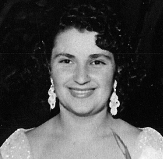
Zara Zeldin Smushkovich

I met my first cousin Zara, known to us as Sofka, in late 1975 on Kibbutz Tzora in Israel.
As far as I can recall, this was our only meeting.
Zara had arrived with her family in 1973 from Riga, Latvia.
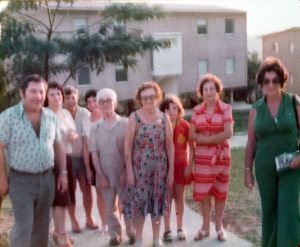
I took this photo of Meir, Zara, Ossie, Bessie, Uncle Isaac,
Aunty Luba, Alla, Aunty Esther, and my mother Rachel.
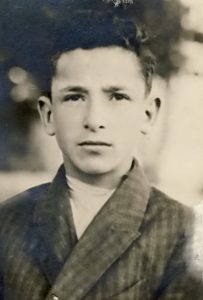
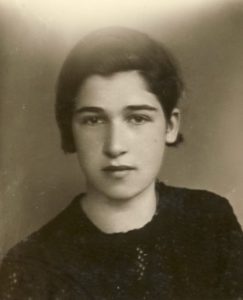
Zara’s father David Zeldin and my mother, Rachel were siblings.

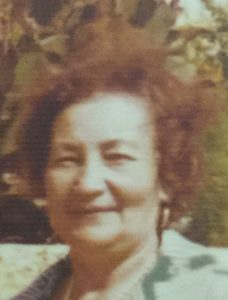
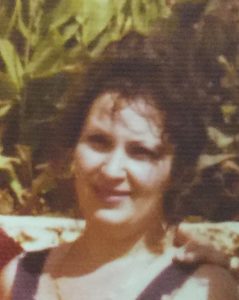

Aunty Esther, David Zeldin’s wife, her daughter Zara and grand daughter Alla.
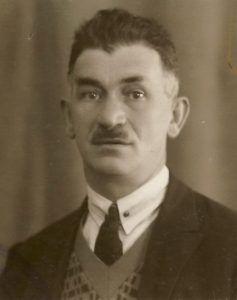
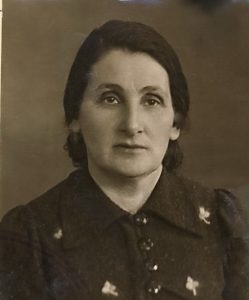
My grandparents Socher and Chasa Zeldin
and their six daughters left Riga for South Africa between 1927 to 1937.
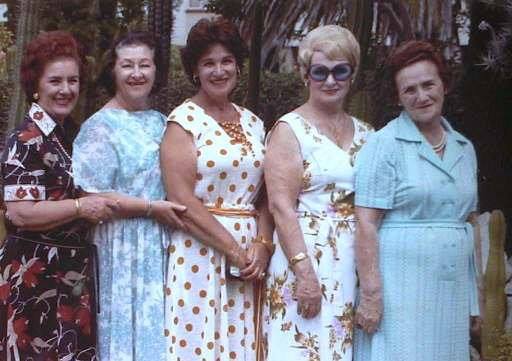
Five of the sisters Yetta, Annie, Rachel (my mother), Guta and Luba (taken in the 1970s)
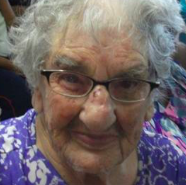
Chana, the youngest sister
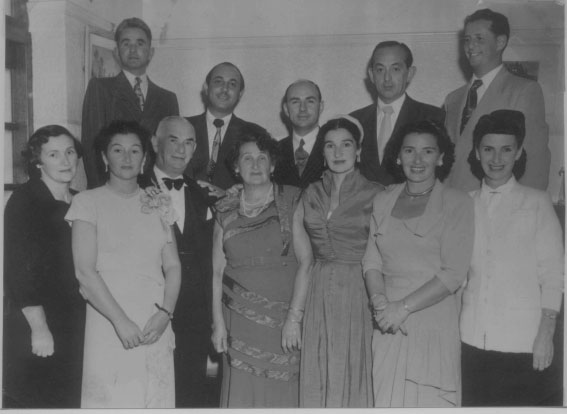
My grandparents, Isocher and Chasa, the married Zeldin sisters and their husbands.
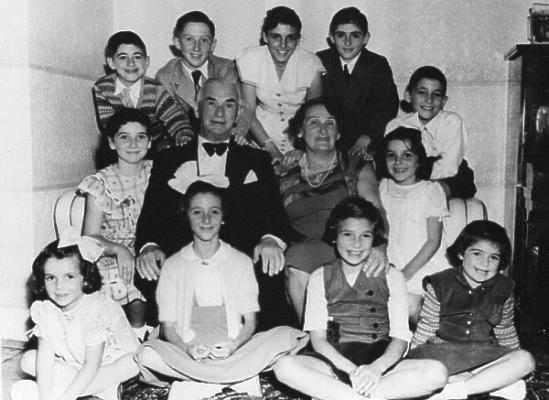
11 of the 15 grandchildren all born in Cape Town
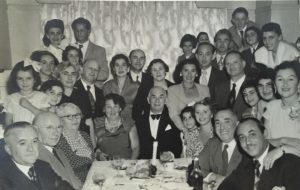
A typical family gathering in the 50s.
Two brothers, Moisey and David were left behind in Latvia.
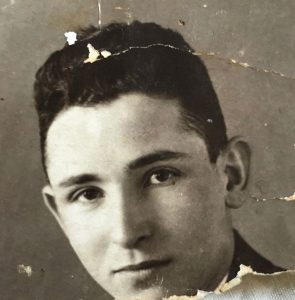
Uncle Moisey, the eldest, died in the Holocaust, around 1941 while his younger brother David joined the Soviet Army and survived.
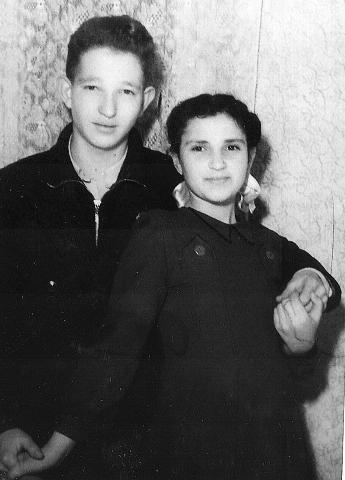
David’s children, Mendel and Zara, spent the war years with their mother Esther in a refugee camp near Tashkent in Uzbekistan.
.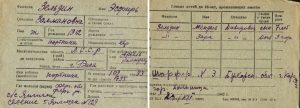

Documents from the Latvian archives showing their refugee status in Uzbekistan.
.
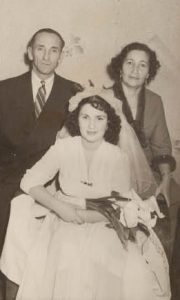
Uncle David, his wife Esther and their daughter Zara at her wedding in Riga in August 1957.
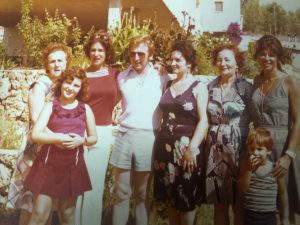
This photo: Aunty Luba, Alla, my mom Rachel, cousin Solly, Zara, Esther, Sorrel and her son Gil in late 70s in Israel.
Zara and her family left Israel for Canada in 1984.
————————————————————————–
In 2001, thanks to Saul Issroff, London based president of South African SIG, I made contact for the first time with Ferenc Koszeg, my Zeldin second cousin in Budapest, Hungary.
The article below describes the amazing way we connected!
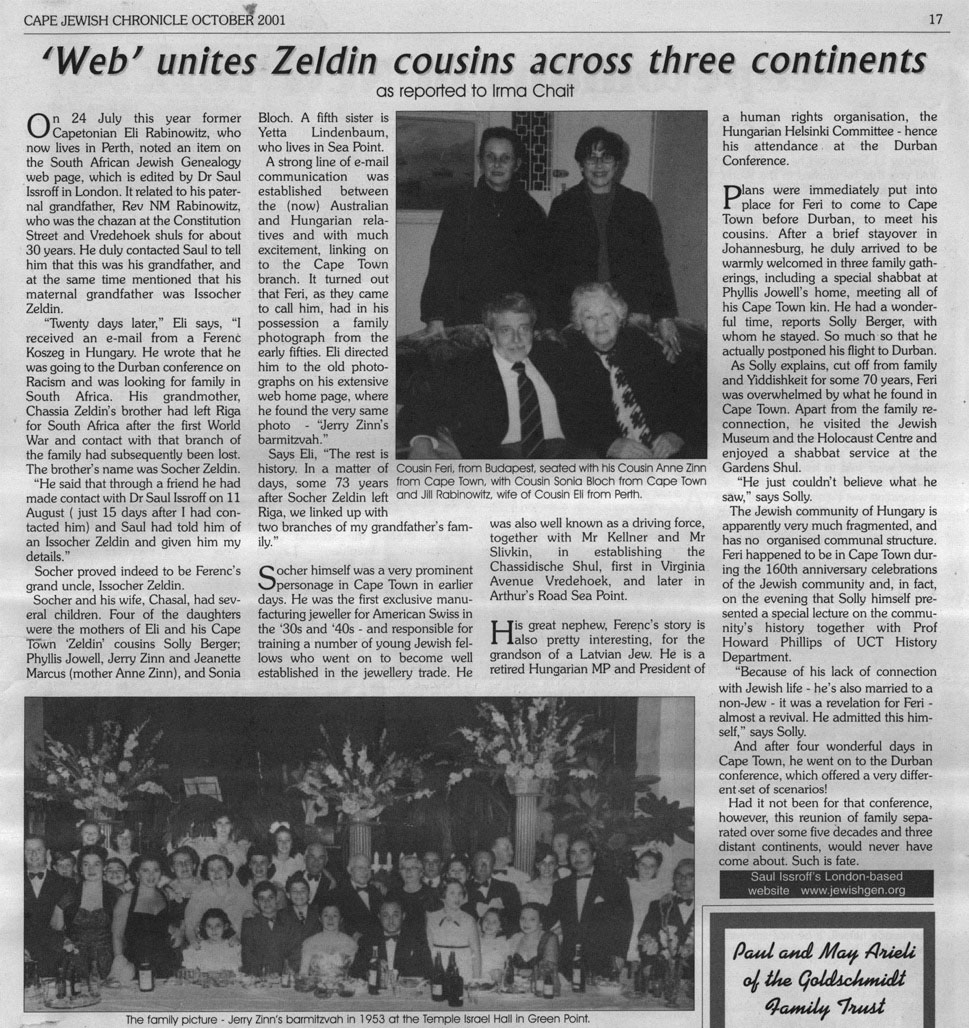
Additionally, Ferenc, known as Feri, introduced me to additional Zeldin family, living in Istanbul:
My grandfather Socher Zeldin, had another sister, Masha who, with her Hungarian husband Sandor, moved to Turkey in the early 1920s. Although they were no longer alive, their daughter and their grandchildren (my second cousins) were in Istanbul.
There was also a second cousin in Washington DC and other Zeldin family, the Bock family, in Dallas. I started corresponding with them.
I made my first trip to the Baltics, Central and Eastern Europe in May 2011, starting in Riga, where I had commissioned research by Rita Bogdanova, archivist at the Latvian State Archives.

With Rita Bogdanova and Saul Issroff in Israel July 2015
Rita found pre WWll material on the Zeldin family in Riga and Dvinsk, known today as Daugavpils.

Rachel (Rael) Zeldin’s passport document.
Using this research as my foundation, I was able to visit family addresses with my guide, Elena Spungina.
Just after leaving Riga, I received the 1960 diary of my late cousin Phyllis Jowell. In it she wrote about meeting our uncle David Zeldin, his wife Esther and children, Mendel and Zara.
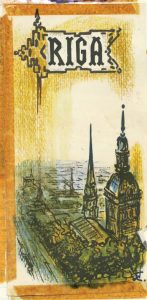
The cover of Phyllis’s diary and photos she had pasted in it:

Rivka & Mendel Zeldin, my cousin, with their son Alex
In the diary he was referred to as Mishka, and his wife and son’s names weren’t given.
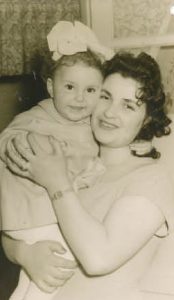
Zara with daughter, Mira
In the diary, she was referred to as Sofka and her daughter’s name wasn’t given.
————————————————————————–
After visiting Latvia, Lithuania and Poland in May 2011, I arrived in Budapest, Hungary and met my second cousin Feri Koszeg for first time, since connecting in 2001.
Other family members joined the party, including Feri’s family, Fanni and her husband David Waitz from New York; Sarah, her husband Peter Magyari, and her brother Aron; my son Neil from Oxford; my nephew Ronen Katz and his daughter Shachar from Israel. Visiting Budapest from Istanbul was our mutual second cousin Mehmet Imre and his wife Billur.
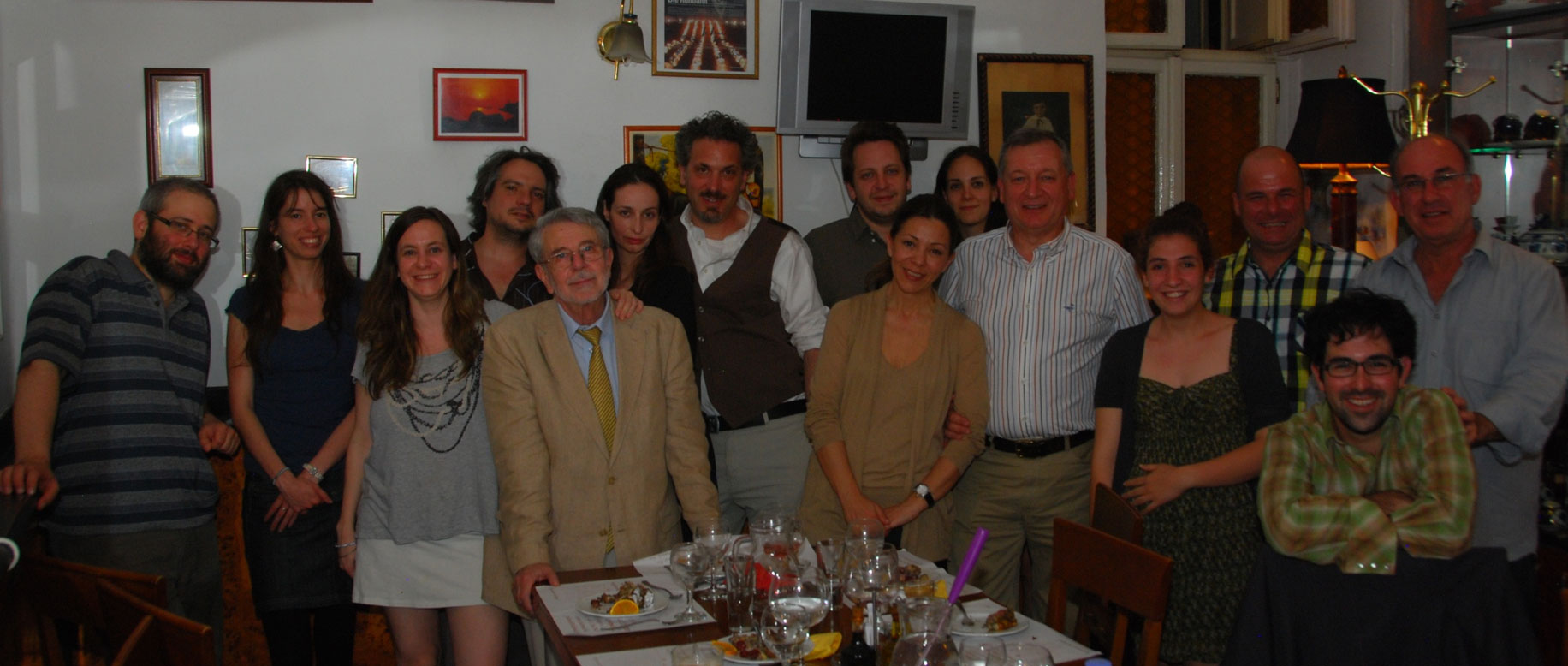
It was a most memorable evening with the three Zeldin second cousins, all grandchildren of three Zeldin siblings from Dvinsk, Latvia.
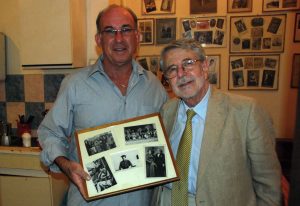
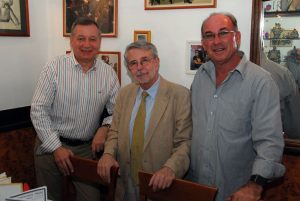
With Feri and the photos that helped bring our families together. The three second cousins: Mehmet, Feri & Eli.
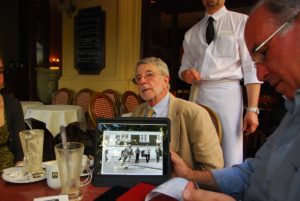
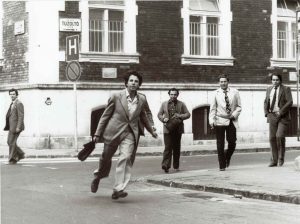
Feri with a famous photo of himself running from Soviet agents.
If you are interested in the background story of this famous photo, go to the 6 minute mark of this video filmed at the Library Of Congress Washington DC in 2014.
I continued my journey to Istanbul where I met Mehmet’s brother Ahmet Imre and his wife, Pinar.
In 2013, I returned to Istanbul, where I met two more of my second cousins, Haluk Atasoy and his wife Sena, and Cihad Atasoy and his wife Seda. These men are second cousins of mine and all have the same Jewish Hungarian grandfather and their grandmother Masha, was my grandfather Isocher Zeldin’s sister.
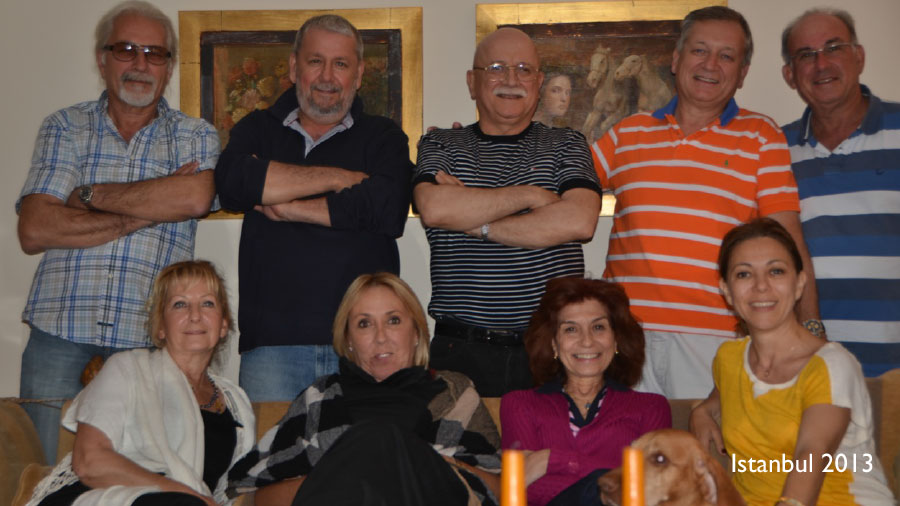
L-R Back: Haluk, Cihad, Ahmet, Mehmet & Eli. Front: Sena, Seda, Pinar & Billur
In the past few years, having found this expanded family, the question of Zara (known to us as Sofka) came up, but no one really knew where to find her nor most importantly, did anyone remember her surname.
I had tried looking for Zeldins on Facebook, but had no luck.
————————————————————————–
Then in June this year I wrote to the Latvian Archives again, but this time to the section of the archives that deals with post WWll and the Soviet era. My friend Rita had suggested I contact the Personnel Archives which has files of families living abroad.
The Archives replied that they had found such documents of the Zeldin family.
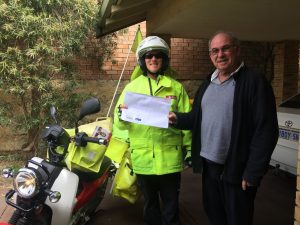
On 22 September 2016, our postie delivered a registered letter from the Latvian Archives.
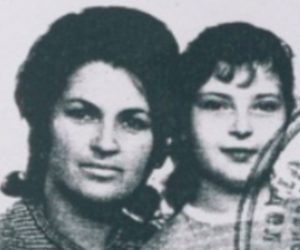
Included were Zara’s and her daughter Alla Khelem’s 1973 joint Soviet passport.

I asked Avigdor Shligel, my Ukrainian friend, to translate Zara’s surname which was written in Russian / cyrillic script.
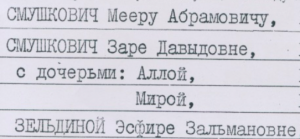
The answer and the key was: SMUSHKOVICH
I posted the following on Facebook and JewishGen:
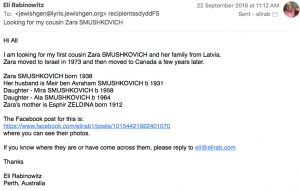
Within an hour a Facebook member, Elena Shapiro Wayne, sent me the Geni page of the late husband of Zara – Meir Smushkovich. I then looked up the names on that Geni tree on Facebook, including Alon Gold, who, according to Geni, was Zara’s grandson.
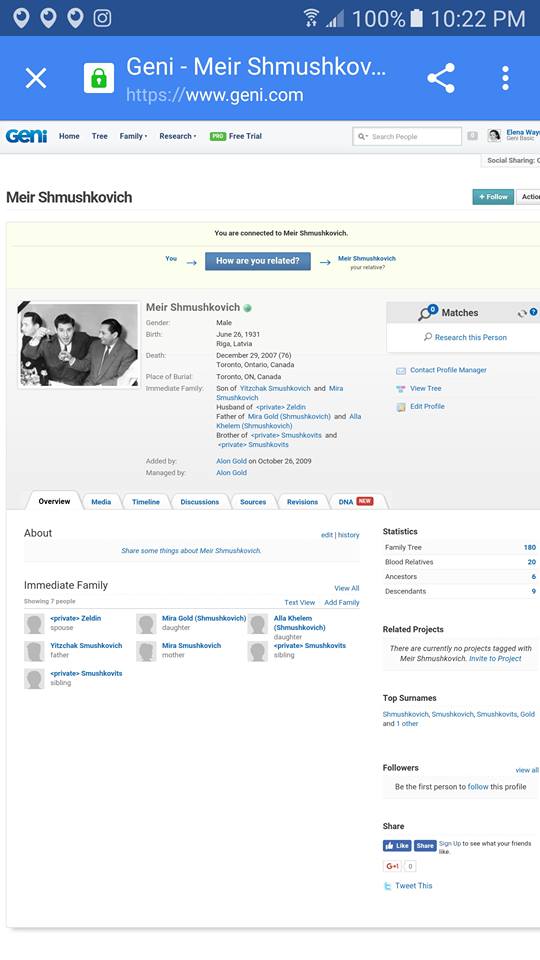
Gert Rogers, from Toronto, saw my post on JewishGen, sent me an email with Zara’s telephone number, which she had looked up in the telephone directory and then called to check that it was Zara.
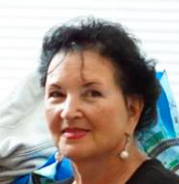
I spoke to my first cousin Zara in Toronto that night. What an amazing experience to make this call!
We were both ecstatic to make this connection! Zara was so happy to be in contact again with her 13 surviving Zeldin first cousins after more than 35 years.
Zara told me that Alon called to tell her that he had been contacted by a “stranger” on Facebook with information about his Zeldin family. As I was unknown to him, he needed to clear it with her as it had come out of nowhere.
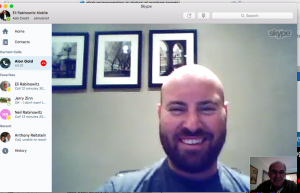
I called Alon Gold the following morning and we spoke for two hours. Like me, he is the go-to person in his family when it come to maintaining family records and ties.
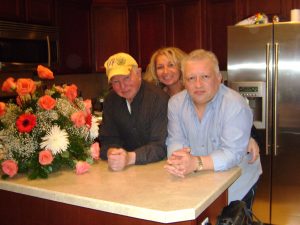
Mendel Zeldin with his children Bella and Alex
Sadly, Zara’s brother Mendel, passed away less than two months ago on 28 July 2016 in Brooklyn, NY. He was 81.
We never met him. Only our late cousin, Phyllis Jowell, met him in 1960 in Riga.
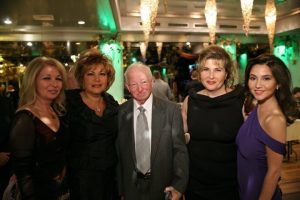
L-R: Bella, Mendels daughter; Alla. his niece; Mendel, Mira, his niece; Angela, his great niece.

Zara with her daughters Alla and Mira.
Here are photos of our “new” family.
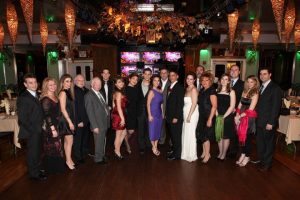
Lucy’s wedding in NY in 2010
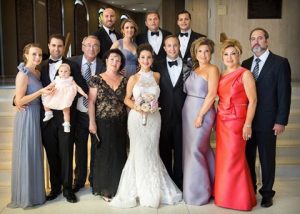
Angela’s wedding in Toronto in 2015
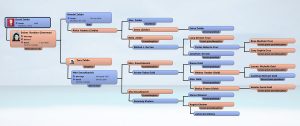
Our new family’s tree!
————————————————————————–
Once I received that registered letter from the archives in Riga, I knew that things would develop quickly.
My thanks go out to my friend Rita Bogdanova at the Latvian State Archives, Avigdor Shligel, Elena Shapiro Wayne and Gert Rogers.
Thanks to Jewishgen.org and Geni.com, it took less than an hour to find Alon Gold and his “baba Sofa”, Zara Smushkovich, my long lost cousin!
There is so much history still to share. We are so looking forward to it.
A rip roaring success story, if ever there was one!
Thanks to my daughter in law Tami for calling me “tangential”. You are right! Just what my sons, the doctors, ordered!
Chag Sameach 5777.
******************************************
From
As many of you know I have been extremely immersed in the Genealogy of my family and Gary’s. I have been active in the genealogy community on Facebook. I had the pleasure of stumbling on a request from a very nice man in Australia looking for family members. I was able to very quickly find a record for one of his ancestors which helped him reconnect after decades! Today on the Jewish NEW YEAR I received a note and this link. At the end of this very wonderful family history I was honored to be mentioned. What a wonderful gift on Rosh Hashana! Eli Rabinowitz here is wishing many years of happiness with your newly found family. I am humbled to have been a small part of this wonderful Mitzvah.
L’Shana Tova.
Please check out this link to hear his story!
http://elirab.me/finding-my-cousin-zara-smushkovich/
**********************************************
From Gert Rogers, Toronto
2 October 2016
Dear Eli
I am so glad that I could help you. Your blog was amazing. I wrote Bubble Segal many years ago and she answered me so I know her by correspondence. Again I am happy for you.
Wishing you and all your family a Healthy and Happy New Year.
Gert
Gert Rogers – Toronto – Searching Goldman Woda Sziiakovich from Mordy, Losice, and Miedzyrzec Podlaski and Solnik Djtelbaum from Staszow all in Poland
From One Photo….
Our South African Jewish Inheritance
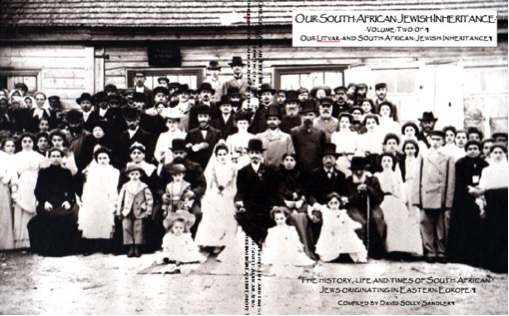
David Sandler has just launched his latest book.

Selfie of David Sandler and me at my home in Perth
Just in from David:
OUR SOUTH AFRICAN JEWISH INHERITANCE compiled by David Solly Sandler published August 2016
The matching volume to OUR LITVAK INHERITANCE published in March 2016
These two volumes tell of the history, life and times of South African Jews originating in Eastern Europe
Like most South African Jews, my ancestors emigrated from Lithuania to South Africa between 1880 and 1920. We were the lucky ones escaping the horrors of the Holocaust and most of us have relatives left behind in Lithuania who perished in the Holocaust.
For about 100 years we generally prospered and multiplied in South Africa and then in the early 1970s, seeking more secure futures for our families, we commenced immigrating to Israel, the UK, the USA, Canada and Australia and by the year 2000 about 50,000 of the 120,000 South African Jews had emigrated.
Like my other books this is a compilation and not a single narrative. It is a gathering of articles, stories and histories that tell us of life and history and Jewish life and history in South Africa from 1880 to 1990. As it is a gathering of articles, stories and histories in some cases we will have two or more different views of the same event.
The purpose of this book is to tell the history of South Africa and our Jewish contribution, with its rich Litvak culture, and to share it with our children and grandchildren. Another purpose of the book is to raise funds for Arcadia and Oranjia, formerly the two Jewish Orphanages in South Africa.
This 511 paged softcovered book has the following sections
1 The early history of South Africa in the Western and Eastern Cape Province.
2 Kimberley and the discovery of Diamonds (Northern Cape)
3 The Establishment of Natal, The OrangeFree State and The Transvaal Boer Republics
4 The discovery of Gold in the Witwatersrand and the founding of Johannesburg
5 The Anglo Boer War 1899-1902
6 Immigration, Yiddish, Zionism and Jewish Culture
7 World War One
8 The Generosity of the S A Jewish Community
9 Landsmanschaften Mutual Aid Societies
10 World War Two
11 Jewish Life in Country Communities (1947 & 1948)
12 Jewish Communities and Personalities
13 Support for Israel during the Israeli War of Independence (1948 & 1949)
14 The Struggle from Apartheid to Multi-racial elections
Between 1981 to 2005 some 40% of Jews, about 47,000 left South Africa. About 13,000 went to Israel, 12,000 to the US, 11,000 to Australia and New Zealand, 6,000 to the UK and 5,000 to Canada.
Most South African Jews today live in Johannesburg (50,000) and Cape Town (16,000), while the other main centres are Durban (2,700) and Pretoria (1,500). Originally, the community was evenly spread throughout the country, but the rural communities began declining shortly after World War II and are today largely defunct.
PG compilation still to come:
I invite all South Africans to share their family histories and photos for the following two books.
– Kehilas (Jewish Communities) of Johannesburg and the Witwatersrand – Jewish Communities of Johannesburg and those larger Rand towns and that fall outside the net of the great work being done by Beyachad in their Jewish Life in the South African Country Communities.
-From Eastern Europe to South Africa – a collection of family histories.
– English translations of the Keidan Yizkor book and The Rakishok Yizkor book.
-The Ochberg Orphans – Volume Two and My Inheritance – my family history – the stories of my four grandparents
Shalom, best wishes and good health to you all and may there soon be peace in Israel
David
David Solly Sandler sedsand@iinet.net.au
Compilations by David Solly Sandler
100 Years of Arc Memories published 2006
The Arcadia Centenary book contains the memories of over 120 children of The South African Jewish Orphanage.
More Arc Memories published 2008
A follow-up of the Centenary book with the memories of more than 100 children. This book includes a section of 17 chapters on the Ochberg Orphans.
The Ochberg Orphans and the Horrors From Whence They Came published 2011
The rescue in 1921 of 181 Ukrainian War and Pogrom Orphans by Isaac Ochberg, the representative of the South African Jewish Community, from the horrors of the Pale of Settlement.
The Pinsker Orphans published 2013
The Pinsker Orphans book – in part a follow up of The Ochberg Orphans book – tells of the life and times of the children from the three Pinsk Jewish Orphanages in the 1920s and like The Ochberg Orphans book is but a small part of a much larger and forgotten part of Jewish History, the horrors suffered by the Jews in The Pale of Settlement between the two world wars.
This Was a Man Reprinted 2014
This book is the life story of Isaac Ochberg as written by his daughter Bertha Epstein and first published in 1974.
Reprinted with the permission of the family of Isaac Ochberg z”l with an addendum added.
Memories of Oranjia, The Cape Jewish Orphanage (1911-2011) published 2014
The book is a collection of the memories of many generations of children (over 120) who were in the care of The Cape Jewish Orphanage which was established in 1911 in Cape Town South Africa.
The Memorial Section of the Rakishok Memorial Book
This book was originally published in 1952 in Yiddish by the Rakishok Landmanschaft in Johannesburg. The book has been translated into English by Bella Golubchik and is for sale with all proceeds going to Arcadia Oranjia and the JDC.
Our Litvak Inheritance published 2016
This book tells of Jewish history, life and times in Lithuania and surrounds – the inheritance of most South African Jews and is the matching volume to Our South African Jewish Inheritance.
Please contact me to order your book – David Solly Sandler sedsand@iinet.net.au
THE SECTIONS OF THE BOOK AND THEIR CONTENTS IN DETAIL
1 The early history of South Africa in the Western and Eastern Cape Province.
This section tells of the early history of South Africa from the first Europen settlement in the Western Cape of the Dutch followed by theEnglish and the spread to the Eastern Cape.
It tells of the expansion eastwards, the exploits of the 1820 Settlers, the clash and 100 year war with the Xhosas (Bantu) and the Great Trek.
It relates the Jewish history during the periods of the Jewish Ministers in the Cape: The Rev. Isaac Pulver 1849-1851, The Rev. Joel Rabinowitz 1859-1882, The Rev. Abraham Frederick 1882-1894 and The Rev. Prof. Alfred Phillip Bender 1895-1894
2 Kimberley and the discovery of Diamonds (Northern Cape)
This section starts with the discovery of diamonds , the early history of Kimberley, and early Jewish Communal history
It tells of the amalgamation of the Kimberley Mines and about the important roles Jews played to bring this about.
It tells of the Jewish Pioneers of Kimberley and of Jewish Communal life
3 The Establishment of Natal, The OrangeFree State and The Transvaal Boer Republics
On the way to the the ‘Promised Land’, be it the highveld of the Transvaal or subtropical Natal, the Voortrekkers (pioneers) engaged in many violent confrontations with the Matabele, the Zulus and other Bantu tribes. At each major encounter, after an initial reverse, the tribes were subdued, their land taken by right of conquest and their people taken as labour.
In Natal the Voortrekkers established a short-lived republic, but, after its annexation by the British in 1843, many Voortrekkers trekked back over the Drakensberg on to the highveld, the lands between the Orange and Vaal Rivers and across the Vaal River.
In 1852 and 1854 the British granted independence to the trekkers in the Transvaal (‘country across the Vaal River’ that became the Zuid Afrikaanse Republiek) and in the Orange River Colony ( the Free State Republic)
The English, bankrupted by the Napoleonic Wars, could not afford to annex the states and the enmity between the English Colonial Government and the farmers (‘Boers’) continued.
Thus, the seeds for further conflict – this time between the Boers and the English – were sown. It needed the spark provided by the twin discoveries of gold and diamonds in 1886 and 1867 respectively – desparately needed by the bankrupt English Government.
Historical Dictionary of the British Empire.
4 The discovery of Gold in the Witwatersrand and the founding of Johannesburg
This section tells of the discovery of gold on the Witwatersrand, the founding of Johannesburg, the early Jewish Pioneers and the formative days of Johannesburg Jewry. It includes details of the Randlords, Notable Jewish Personalities, the opening of the Park Synagogue by Paul Kruger and the Jamesion Raid.
5 The Anglo Boer War 1899-1902
This section discusses the phases of the Anglo Boer War: the scorched earth policy adopted by the British and the concentration camps they established in which over 26,000 Boer women and children perished from starvation and disease.
It tells of the Boer prisoners of war and The Treaty of Vereeniging followed by The Boer War in the Hebrew Press, Boerejode, Jews in the Boer Forces, The Russians and the Anglo-Boer War and the Jews on The British Side.
Next we tell of Jewish Refugees at the Cape during The Anglo-Boer War followed by Life in Pretoria and Johannesburg during and after the Boer War and we have the life story of Samuel Marks, Pretoria’s most prominent Jew.
We end with the Union of South Africa in 1910
6 Immigration, Yiddish, Zionism and Jewish Culture
In this section we pause, step back and revisit our South African Jewish Inheritance from different perspectives.
We start off with Jewish Immigration and the struggle to get Yiddish accepted as a European Language.
It tells of the birth of Zionism and Jewish Culture in South Africa and the culture clash between the English and Litvak (Eastern European or Russian) Jews.
We end with the Traditions of South African Litvak Jews
(In the next section are details of The South African Jewish Congress that gained the support of Jan Christiaan Smutsthe SA Boer leader who shared in the creation of Israel. )
7 World War One
This section tells of World War One (The Great War) first from a global and then a South African perspective.
It tells of the horrors of the war in ‘The Pale of Settlement’ (Eastern Europe) and the help given by the South African Jews to their bretheren in the Pale and in Palestine
Then we have details of The South African Jewish Congress seeking and gaining the support of Jan Christiaan Smuts the Boer who shared in the creation of Israel
We end with the The Spanish Influenza Pandemic 1918-1919
8 The Generosity of the S A Jewish Community
“This may help to explain how South African Jewry has acquired the characteristics which distinguish it as a group. It has a world-wide reputation for liberality towards those of its co-religionists who are in need, and for staunch support of the Zionist movement. It is also recognised as a well-organised and relatively united community.
Being largely descendants of Lithuanian Jewry, South African Jews are a fairly homogeneous group, unlike those of the United States of America. They have inherited some of the qualities of the Litvaks – their warm-heartedness and generosity, their practical-mindedness, a strong feeling of Jewish solidarity, and a love of learning combined with a somewhat critical attitude to religious traditions, their religion being often more of the head than of the heart.
Enterprising and hard-working, they have been able to take advantage of the opportunities offered by a new and developing country.”
Extract from THE JEWS IN SOUTH AFRICA Edited by Gustav Saron and Louis Hotz. Printed in 1955
The Generosity of the S A Jewish Community, Jewish Institutions, Funds and Appeals
This section starts with the early history of The Johannesburg Chevrah Kadisha, The South African Jewish Orphanage (Arcadia) and The Cape Jewish Orphanage (Oranjia), two institutions that still look after Jewish children in need today.
This is followed by three chapters of the good work done byThe United South African Jewish Relief, Reconstruction and Orphans Fund (1915-1925) that funded the rescuein 1921 of 181 Pogrom Orphans from the horrors of the Ukraine and Poland by Isaac Ochberg.
We end withThe 1930 Annual Report of the South African Jewish Orphanage with the names of thousands of supporters not only from Johannesburg but from many surrounding country areas.
9 Landsmanschaften Mutual Aid Societies
To help one another and the new immigrants arriving with virtually nothing Landsleit (people from the same towns or districts) banded together to form Landsmanschaften (Mutual Aid Societies) that helped the sick and poor, burried the dead and provided interest free loans to help members start businesses. They also provided a place where mainly men could gather and socialise.
In South Africa there were Landsmanschaften from numerous towns: Anykster ,Birzer ,Dwinsk, Keidan, Kelmer, Kovno, Krakinover, Kroze, K]
10 World War Two
This section first documents the rise of Anti-Semitism in the 1930s from news articles and from Worlds Apart
It details South Africa’s military contributions and casualtiesand lifeduring the war and tells about”up north”
It tells of the Jews in WWII and gives details of individuals who made the supreme sacrifice, individuals who served and life as a POW
This section ends with Victory Day and with the arrival of the news of the Holocaust
11 Jewish Life in Country Communities (1947 &1948)
In this sectionArthur Markowitz tells of Jewish Life in South African country communities in his Nationwide Survey of Jewish Communities published in The South African Jewish Times in 1947-8
He tells of the Jewish contribition to the developement of agriculture and industry in the towns throughout South Africa and highlights the special contributionsof some Jewish individuals.
From the very early days Jews lived in almost every country town in South Africa and they played a very important roles from the early development of these towns. Typically they were the traders and professionals,running the General Dealer Store (Algemeene Handelaar), the Hotel and bar and they were the Doctor and Lawyer and some were Farmers
12 Jewish Communities and Personalities
This section of the Jewish Communities and Personalities of Durban, Bloemfontein and Johannesburg, supplements Arthur Markowitz’s Nationwide Survey of South African Jewish country communities in section 10.
We commence with compilations on Durban and Bloemfontein the main cities of Natal and the Orange Free State. This is followed by compilations on three Johannesburg Jewish Communities: Rosettenville / La Rochelle, Fordsburg / Mayfair and Parktown.
In Parktown, a suburb of very large estates, we focus on the South African Jewish Orphanage (Arcadia) and remember individuals connected to Arcadia, not only for their contribution to Arcadia, but because of their contribution to the broader community. (These articles come from the two Arcadia Memory Books and The Ochberg Orphans by David Solly Sandler )
13 Support for Israel during the Israeli War of Independence (1948 – 1949)
This section tells of thesupport given to the newly created State of Israel in their fight for independence by the Jews in South Africa
The Zionist Federation in South Africa actively recruited those experienced and who had fought in WWII and sent them to Israel. They specifically recruited pilots and if fact had a flying school in Germiston.
There are extracts from South Africa’s 800 and the names of the 800 South Africans volunteers who fought in Israel’s War of Birth and we remember the 85 South Africanswho fell.
The section ends with details of some who fought and fell in defence of Israel
14 The Struggle from Apartheid to Multi-racial elections
This section commences with the history of Apartheid and is followed by the treason trials and details the resistance and events leading to multi-ratial elections.
This entire section is sourced from Worlds Apart by Colin Tatz, Peter Arnold and Gillian Heller, apart from ‘The facts about South African Jews in the Apartheid Era’ by Maurice Ostroff.
We end with details of White Emigration
Once again I feel honoured to be the compiler of this book that belongs to the Jewish Community and is a collection of articles, extracts of books and family histories kindly shared and entrusted to me by many people.
Thank you to the following that have shared their family histories, their articles and their books:
Andrew Cassel and Aryeh Shcherbakov, of the Keidan Association of Israel and the USA, for permission to use extracts of The Keidan Yizkor Book published in Hebrew in 1977
Colin Tatz, Peter Arnold and Gillian Heller, for sharing parts of their book Worlds Apart
Diane Wolfson for permission to use extracts of The Pretoria Jewish Community up to 1930 by Mrs Myrtle Todes, Mr Selwyn Zwick, Mrs Naomi Nowosenetz, Dr Rayme Rabinowitz, Mrs Avril Cohen, Mrs Jill Katz (editor), Mrs Mary Kropman and and Mr Ralph Lanesman.
Joe Woolf for sharing his family history From Shatt (Seta) to South Africa and parts of South Africa’s 800 The Story of South African Volunteers in Israel’s War of Birth Henry Katzew.
Louis Zalman Glick Touyz for sharing his article Traditions of South African Litvak Jews and other articles
Dave Sacks of the SAJBD for sharing his articles on the Boer War
Saul Issroff, London UK of South African Jewish Genealogy for sharing his article early South Africa Jewish History and Bloemfontein
Other books sourced
-Birth of a Community by Chief Rabbi professor Israel Abrahams
-The Fordsburg-Mayfair Hebrew Congregation 1893-1964 by Bernard Sachs
-The Jews in South Africa, Edited by Gustav Saron and Louis Hotz
-The Nationwide Survey of the South African Jewish Community By Arthur Markowitz
-The Vision Amazing by Marcia Gitlin
-The War Report by J E H Groble
Much thanks go to Bennie Penzik for helping with the editing of the book
Thank you to Michael Perry Kotzen, an Ex Arcadian actor and nonagenarian, from Sydney, the most prolific contributor of Arc Memories, who has helped willingly with the proofreading of this book.
A very great thanks goes to Antoinette Weber, my partner of the past 14 years, who gave very generously of her time and assisted with the typing and proofreading. I have once again tried to match the very high standard of formatting she set in the first volume.
Thanks must again go to two very close Arc ‘brothers’, David Kotzen and Dr Solly Farber who passed away in July 2002 a day apart. They both inspired and encouraged and helped me and set me on the path to compiling books. I sometimes feel that it is not by chance that I share with them my names David and Solly. I hope that David and Solly, as well as Doc and Ma and all Old Arcs who have ‘bunked over the hill’ enjoy this book from above.
As at the end of February 2016 over R1,150,000 had been raised for Arcadia and R60,000 for Oranjia from book sales. We still have many copies of the Arcadia Memory books, The Ochberg Orphans books and other books for sale with the full proceeds going to the charities that still continue to look after children. See the back of the book for details of books and charities and contact me please. You can pay for the books locally and have them delivered to friends overseas.
PG compilation still to come:
I invite all South Africans to share their family histories and photos for the following two books.
– Kehilas (Jewish Communities) of Johannesburg and the Witwatersrand – Jewish Communities of Johannesburg and those larger Rand towns and that fall outside the net of the great work being done by Beyachad in their Jewish Life in the South African Country Communities.
-From Eastern Europe to South Africa – a collection of family histories.
– English translations of the Keidan Yizkor book and The Rakishok Yizkor book.
-The Ochberg Orphans – Volume Two and My Inheritance – my family history – the stories of my four grandparents
Shalom, best wishes and good health to you all and may there soon be peace in Israel
David
David Solly Sandler sedsand@iinet.net.au
Litvaks & IAJGS in Seattle
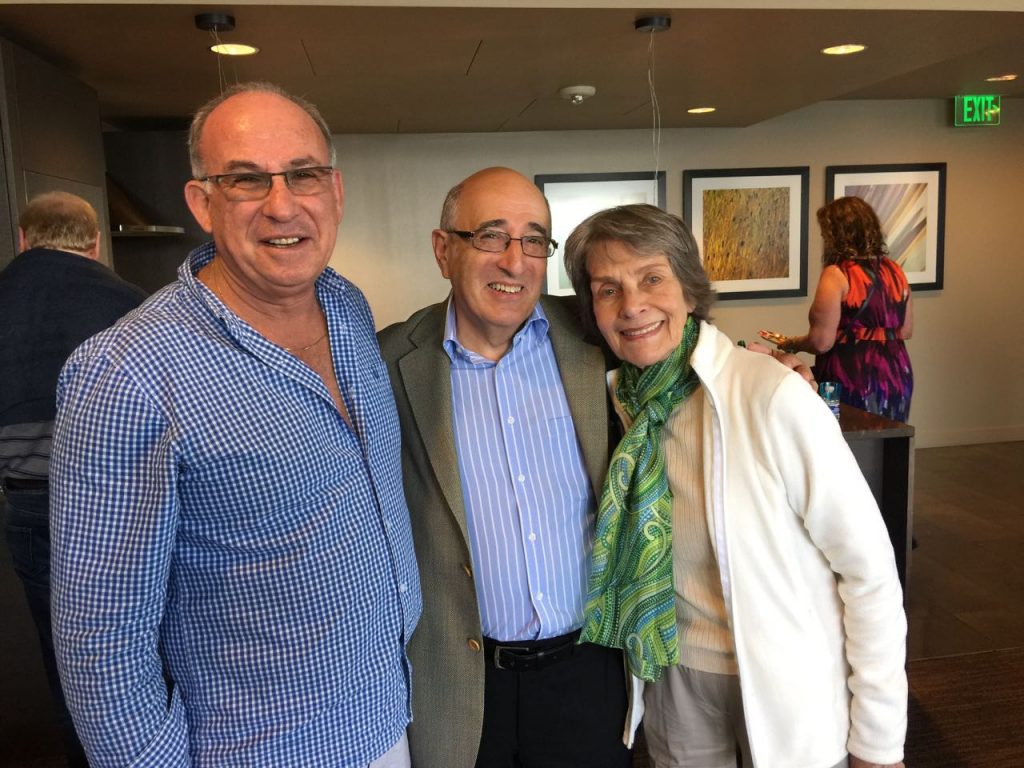
With Stuart Rosenblatt (Ireland) & Carol Hoffman (Israel)


From Stan Smookler:
Eli is a Genealogist of note……….. Eli Rabinowitz – ‘Gib A Kuk’ at his blog… E-mazing news from ‘Der Heims’ & The ‘Beloved Country’…. http://elirab.me/ ..
Eli has been to Seattle (from Perth) this past week for a few lectures on the Shtetlach……. And quite E-mazing that my old Stan & Pete partner & Chaver, Dennis Cohen’s Boet Lester & Barbara were at the lecture …..Lester & Barbara both worked at Stan & Pete and Barbara (Kotzen) is from Lichtenberg, having gone to the Lichtenberg Hoer Skool… Put up the pictures Eli sent, BUT…..I don’t recognize the other people, so have labelled the picture with Eli & the Cohen’s…. http://stantgsm.com/category/pictures/4
[iframe src=”http://stantgsm.com/view-post/eli%20rabinowitz%20in%20seattle%20%20olive%208%20condo%20for%20a%20talk%20on%20der%20heim/4204″ width=”100%” height=”500″]
The International Associate of Jewish Genealogical Societies IAJGS held their annual conference for 2016 in Seattle WA at the Sheraton Hotel.

Here are some images from the first three days of the conference:
IAJGS Conference Day 1
IAJGS Conference Day 2
IAJGS Conference Day 3
These are the program notes for:
GENEALOGY FOR JEWISH EDUCATORS
Talk to people who are researching their family’s history, and many will tell you how much they regret not starting earlier. For example:
I never talked to Zayde about his recollections of the Old Country, his parents, how he got here, the family he left behind and those who came over. Who were they? How did they live? When my parents went to those boring Cousins’ Club get-togethers, I stayed home. I didn’t really get to know my cousins. Who are the people in those pictures on the walls when I was growing up? And in that drawer-full of old photos Mom used to keep? I never asked.
For those who teach in formal and informal settings, getting started in family research and introducing young people to genealogy is the focus of a special forum, Genealogy for Jewish Educators, on Sunday, August 7, 2016, the first day of the week-long 36th IAJGS Conference on Jewish Genealogy.
9 a.m. – 2 p.m. The day begins with a kosher breakfast and kickoff address by Rivy Poupko Kletenik, Head of School at the Seattle Hebrew Academy and a nationally recognized author and lecturer on all things Jewish. Then two workshops, giving you a choice among three topics for each session, followed by lunch and An Interactive Learning Walk – a festival of ideas and programs for schools, classrooms, youth and family programs.
Genealogy for Jewish Educators | IAJGS 2016 8/04/2016
THE SCHEDULE
9:00 – 10:00
BREAKFAST AND KEYNOTE ADDRESS
WHAT’S JEWISH ABOUT JEWISH GENEALOGY? EVERYTHING !
Rivy Poupko Kletenik
Jewish Genealogy is family history and family stories, community history and world history. Jewish genealogy is Torah.
10:15-11:15 WORKSHOP CHOICES
A. NUTS AND BOLTS OF JEWISH GENEALOGY FOR BEGINNERS
Ken Bravo
This program is designed for those who are new to Jewish genealogical research as well as those who are more advanced. We’ll present practical tips and hints on where and how to look for clues and data, some of which are common with other kinds of genealogical research and some that are more uniquely Jewish, such as Jewish newspapers, cemetery records and records of Jewish organizations.
B. WHAT YOU SHOULD KNOW ABOUT DESIGNING AN INTRODUCTION TO JEWISH GENEALOGY
Joel Weintraub
Joel will discuss the planning and constructing of an Introduction to Jewish Genealogy (IJG) talkfrom an educator’s point of view. Why do an IJG? (recruitment and retention) Who are our target individuals? What level of information and methodology to include? (Blooms Taxonomy) What kinds of results do we want? (Learning Outcomes)
C. HANDS-ON TOMBSTONE DECIPHERING
Madeleine Isenberg
Do you have photos of ancestral tombstones with Hebrew lettering? Don’t assume it’s just Hebrew. It could be Hebrew or maybe it contains Aramaic, Yiddish or Ladino words. Bring photos or e-mail images to the workshop. We can analyze them together as a joint learning experience. Things to learn: What are the most common texts or patterns? Where to look on a tombstone. What to skip when looking for essentials. How to recognize Rashe Tevot (acronyms). Handouts for future use.
11:30 – 12:30 WORKSHOP CHOICES
D. INTRODUCTION TO JEWISHGEN AND JEWISH GENEALOGY
Avram Groll
JewishGen is a unique website – it’s free, easy to use, and features thousands of databases, research tools. JewishGen offers both archival and networking components. Common challenges that people encounter when researching their family history and how JewishGen can help.
E. PERSONALIZING JEWISH HISTORY
Janette Silverman
This workshop will explore ways to capture your students’ attention (whether adults or children) and memory while teaching Jewish history. Using the history you NEED to teach and which they NEED to learn, we will explore ways to make the history about THEM, capturing their attention, teaching them skills and helping them to remember what they have learned.
F. CRAFTING HISTORY: BRING YOUR ANCESTORS BACK TO LIFE
Mary Roddy
When you start talking about genealogy, how long is it before your sister’s eyes glaze over? Join the club. But this talk will give you ideas to display your family history knowledge in unusual and compelling ways and soon have your students and their families asking you question. Ms. Roddy will present more than a dozen projects that crafters can create at home with easy-to-find supplies, using ancestral photos and artifacts. Projects include jewelry, household and holiday decorations, quilts, shadow boxes, calendars and more. Each of these projects invites questions or comments and gives us an easy way to talk about our ancestors. How-to instructions for projects will be provided.
Let’s Catch Up At IAJGS In Seattle

Hi from Perth, Australia.
I start my long 24 hour trek early tomorrow from Perth to Seattle.
I will be in Seattle until Tuesday evening.
I am giving a presentation at a South African Tea Party this Saturday afternoon. This will be of interest to those wanting to connect with their shtetl.
This talk is being held within walking distance from the Sheraton.
For more details, see:
http://elirab.me/litvak-portal
I plan to spend most of Monday and Tuesday meeting up with the many people I have communicated with via the 70 JewishGen KehilaLinks I write and manage.
These Jewish websites cover many countries and regions – Lithuania, Latvia, Estonia, Poland, Germany, Belarus, Russia, South Africa, Australia and China.
The list is here:
http://elirab.me/litvak-portal/kehilalinks/
If you would like to catch up with me to discuss these, your shtetl, heritage travel or just to say hello, email me at eli@elirab.com. I am likely to be near the lobby.
See you soon!
Best regards
Eli Rabinowitz
Perth, Australia
eli@elirab.com
Updates – Muizenberg and Others
Four items today
- Jack Aaron’s speech
- Rabbi Mirvis on Teresa May
- Teresa May’s speech at the Finchley Untied Synagogue 2015
- A visit by the Stropkover Rebbe
Jack Aaron’s opening speech at the Vancouver opening of Memories of Muizenberg Exhibition
Subject: Chief Rabbi Mirvis on Theresa May
Date: 17 July 2016 at 11:01:00 PM GMT+3
As David Cameron’s tenure as Prime Minister ends, I wish to take this opportunity to thank him for his deep friendship and for his unwavering commitment to promoting the values of decency, respect, liberty and responsibility, which we all hold so dear.
I have been privileged, in particular, to have worked alongside Mr Cameron to ensure that Britain remembers the Holocaust and educates generations to come about the lessons we must learn from it. He is a man who not only speaks with great principle and conviction but who acts upon what he believes. I know that the strong relationship he enjoys with the Jewish community will endure for many years to come.
Today, Theresa May becomes Prime Minister at a time of great political, social and economic uncertainty. Few people are more talented or better qualified to tackle these immense challenges. I recall the speed and the sensitivity with which she reached out to the Jewish community following the terror attacks on Jewish targets in Europe last year. As she made clear then – “Without its Jews, Britain would not be Britain”. She has proved herself to be a friend and champion of our community and of other faith communities who share her values of tolerance and understanding.
Last night, on the eve of her becoming Prime Minister, Theresa May kept a longstanding arrangement to join Valerie and me at our home for dinner. The fact that she did this in the midst of critically important preparations before taking up office is a reflection of her strong desire to keep to her commitments and the esteem in which she holds the British Jewish community. I was delighted to have the opportunity to give her my blessings at this very auspicious time.
I wish her every success as Prime Minister and look forward to building upon our warm relationship over the coming years
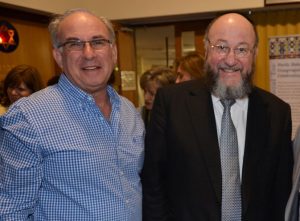
Speech by Teresa May at Finchley United Synagogue last year when she was Home Secretary.
Bubbles – From Stellenbosch to Australia’s Top End
Bubbles – From Stellenbosch to Australia’s Top End
a new publication by Bubbles Segall

Bubbles Segall was born in South Africa and moved to Australia in 1974.
She moved to the Northern Territory in 1976 where she worked for thirty-three years as a midwife, as a Community Health Nurse and as a Community Development Officer in Darwin and in remote Aboriginal communities.
“This autobiography of Bubbles tells the story of her journey from Cape Town to the Northern Territory of Australia, which more than lived up to the enchantment she held in her childhood.”
This is her story.
From Bubbles:
After many months of slaving over my laptop, I have finally finished a book about my life.
The title: Bubbles. From Stellenbosch to Australia’s Top End.
To celebrate, I had a launch at our favourite Irish pub on Sunday 26 July 2016 with somewhere between 60 and 70 people friends and family.
To order copies go to the website http://www.underthesun.net.au/
Click on Buy Books
Scroll down to Quick Links (listed by author’s surname).
Click on S-Z and find my book
Love from Bubbles Segall” bubblessegall@gmail.com























































































